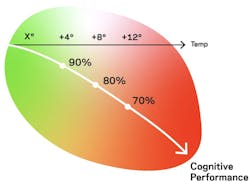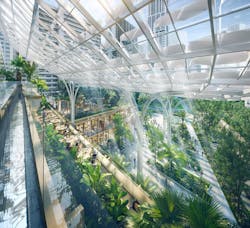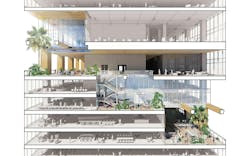Cooling the mind: Neuroscience-informed design strategies for a warming climate
The planet is getting hotter. And while much of the conversation centers on heat's effect on the environment, rising temperatures also impact focus, memory and learning. Studies show that for every 4°F increase in temperature, a person's cognitive performance drops by approximately 10%.
Over the past ten years, we’ve worked together—one of us a molecular biologist and cognitive neuroscientist, the other an architect—to discover how brain science leads to better buildings generally. This year, our collaboration shifts to the human side of climate change.
In this piece, we explore the link between rising temperatures, the brain, behavior, and well-being. We also share our perspectives on neuroscience-informed design solutions that can protect mental performance: something everyone should pay attention to, whether in a hospital, workplace or at home.
The Neurological Impact of Rising Temperatures
- Optimal cognitive performance occurs between 68-72°F
- A 1° rise in temperature reduces how well the brain plans and focuses by 2.4%
- 4°F temperature increase leads to a drop in individual cognitive control by 10%
The Behavioral and Mental Health Consequences
Higher temperatures also correlate with aggression and social tension including:
- Increased violent and non-violent crime
- Heightened reactive aggression
- Mental health-related mortality
- Worsening symptoms for individuals with pre-existing mental health conditions
3 Design Imperatives for a Warming World
As temperatures rise, building design has an opportunity to enhance comfort, cognition and resilience. At the same time, some common approaches—like heavy reliance on air conditioning—increase energy use and carbon emissions, highlighting the need for smarter, more sustainable strategies.
Below, we delve into resilient solutions that lower energy costs while supporting human performance. From shade and natural cooling to socially connected spaces, these interventions offer a framework for buildings that help people thrive.
1. Shade as a Primary Design Intervention
Filter the Sun, Don't Reflect It
Designing for heat often means reflecting sunlight—using light-colored materials or glazed surfaces to bounce it away. But it's no longer enough to simply deflect the sun. Instead, intercepting it through shade structures, canopies and tree cover can reduce heat gain and maximize brain performance.
Strategic Structures
Canopies, awnings and overhangs offer precise, scalable solutions to reduce heat exposure. These architectural interventions cool surfaces and create microclimates that protect bodies and minds, turning buildings into allies in climate resilience.
Living Solutions that Restore
Hotter temperatures can negatively affect peoples' behavior, making them more irritable, aggressive and even less mentally stable. Trees, vegetation and water elements do more than reduce ambient temperatures; they soothe the nervous system, ease stress and promote mental clarity.
2. Fluid Dynamics for Natural Cooling
Nature as Climate Control
Breezeways and cross-ventilation techniques channel natural wind flow through a building, drawing in cooler air and pushing out warm, stale air. Similarly, solar chimneys use the sun's energy to heat air, which then rises and creates a draft that can be used to ventilate a building.
By reducing reliance on mechanical cooling, these strategies help maintain comfort while conserving energy.
3. Social Resilience Design to Promote Equity
Calm by Design
As temperatures rise, so can stress, agitation, and erratic behavior, driven by reduced cognitive function. Dedicated calming spaces offer a quiet, temperature-controlled refuge that helps regulate the nervous system, restore focus and reduce conflict.
Urban Oases for All
Rising temperatures disproportionately impact urban communities. By targeting ideal zones like transit hubs and incorporating cooling strategies—tree canopies, shaded streets, evaporative cooling, improved airflow—cities can reduce heat stress, mitigate heat islands, and promote health, equity and social connection.
Emerging Ideas for a Changing Climate
As the climate crisis intensifies, design can help safeguard how we think, feel and function. Insights from neuroscience open new possibilities—like strategies for maintaining thermal comfort, using natural cooling to reduce heat stress and fostering social connections that strengthen resilience.
Partnering for a Resilient Future
Climate change is advancing at a pace and intensity that pushes the limits of adaptation. Design has a vital role to play—creating spaces that foster collaboration and fresh thinking, while also cutting carbon use. Moving forward, ongoing partnerships between scientists and designers are essential to develop practical, well-rounded solutions that can meet this challenge head-on.
About the Author
NBBJ
NBBJ creates innovative places and experiences for organizations worldwide, and designs environments, communities, and buildings that enhance people’s lives. Founded in 1943, NBBJ is an industry leader in healthcare and corporate facilities and has a strong presence in the commercial, civic, science, education and sports markets. To view all of NBBJ’s ideas, visit our website or follow us on Facebook, LinkedIn, Twitter






